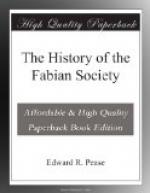The Manifesto led to the resignation of a few distinguished members, including Professor D.G. Ritchie, Mrs. Bateson, widow of the Master of St. John’s College, Cambridge, and more important than all the rest, Mr. H.W. Massingham. He was on the Continent when the Manifesto was in preparation; otherwise perhaps he might have come to accept it: for his reply, which was published in the same magazine a month later, was little more than a restatement of the case. “The only sound interpretation of a model employer,” he said, “is a man who pays trade union rates of wages, observes trade union limit of hours, and deals with ‘fair’ as opposed to ‘unfair’ houses. Apply all these tests and the Government unquestionably breaks down on every one of them.” If this was all that an apologist for the Government could say, no wonder that the attack went home. The opponents of Home Rule were of course delighted to find another weak spot in their adversary’s defences; and the episode was not soon forgotten.
In January the article was reprinted with much additional matter drafted by Bernard Shaw. He showed in considerable detail how a Labour Party ought to be formed, and how, in fact, it was formed seven years later. With our numerous and still flourishing local societies, and the newly formed I.L.P., a large circulation for the tract was easily secured. Thousands of working-class politicians read and remembered it, and it cannot be doubted that the “Plan of Campaign for Labour,” as it was called, did much to prepare the ground for the Labour Party which was founded so easily and flourished so vigorously in the first years of the twentieth century.
At this point the policy of simple permeation of the Liberal Party may be said to have come to an end. The “Daily Chronicle,” under the influence of Mr. Massingham, became bitterly hostile to the Fabians. They could no longer plausibly pretend that they looked for the realisation of their immediate aims through Liberalism. They still permeated, of course, since they made no attempt to form a party of their own, and they believed that only through existing organisations, Trade Unions on one side, the political parties on the other, could sufficient force be obtained to make progress within a reasonable time. In one respect it must be confessed we shared an almost universal delusion. When the Liberal Party was crushed at the election of 1895 we thought that its end had come




